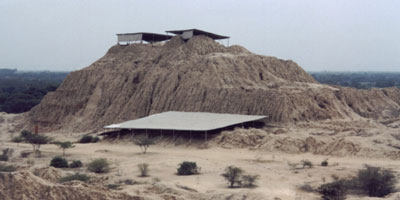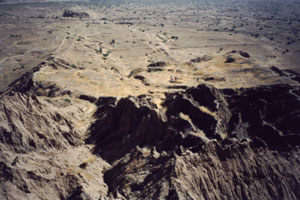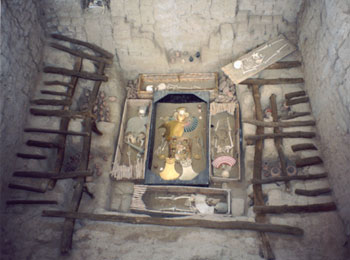|
|
|
|
| |
Túcume
Next, we traveled north to Chiclayo to visit Túcume.
Túcume was a dizzying combination of Moche, Lambayeque, Sicán, Chimú and
Incan structures. The Moche and Lambayeque cultures each built several
adobe huacas, the Sicán built their capital around Huaca Larga, the Chimú
built a large ciudadela-like administrative center for controlling the
northern reaches of their empire, and the Incas built stone structures
at the top of the mountain.  The
Moche and Lambayeque huacas looked like any other those cultures built,
with multiple levels, ramps turning corners on the way up the huaca, and
fairly uniform adobes with mit'a marks. The Chimú administrative center
looked like the entire structure could have fit within one of the plazas
the Chimú built in their ciudadelas at Chan-Chan, but it was still characteristically
Chimú, with plazas and audiencias with restricted access. The Incan portion
of the site was barely visible as crumbling stone walls around the peaks
of the mountain (if it can be called a mountain). With Dan Sandweiss as
our guide, we explored the industrial sector of the site, looking for
evidence of metalworking. We found a ceramic whistle, potsherds used to
line the kilns, and beads of copper waste among other random artifacts.
All that was left of the structures there were rolling mounds of debris. The
Moche and Lambayeque huacas looked like any other those cultures built,
with multiple levels, ramps turning corners on the way up the huaca, and
fairly uniform adobes with mit'a marks. The Chimú administrative center
looked like the entire structure could have fit within one of the plazas
the Chimú built in their ciudadelas at Chan-Chan, but it was still characteristically
Chimú, with plazas and audiencias with restricted access. The Incan portion
of the site was barely visible as crumbling stone walls around the peaks
of the mountain (if it can be called a mountain). With Dan Sandweiss as
our guide, we explored the industrial sector of the site, looking for
evidence of metalworking. We found a ceramic whistle, potsherds used to
line the kilns, and beads of copper waste among other random artifacts.
All that was left of the structures there were rolling mounds of debris. |
|
| |
|
|
| |
 Pampa
Grande Pampa
Grande
Following Túcume, we adventured to Pampa
Grande, the former Moche kingdom capital. Although Túcume was enormous,
considering Pampa Grande had a much shorter period of occupation-serving
as the Moche capital during phases IV and V, its size was even more
impressive. The huaca there was larger than anything at Túcume, and
the city reached all the way to the road we arrived on. Unfortunately,
the huaca itself was a disaster after several El Niños worth of erosion.
The ramp was all but gone, and once we reached the top, we saw that
the interior had also eroded away, leaving a treacherous shell of adobe
bricks. The museum at Pampa Grande was truly classic, sporting dancing
children, a snakeskin, and Moche pottery we were actually able to handle
and feel for weight. Also dealing with pottery here, we learned that
if a ceramic was signed before firing, it was probably the maker's signature,
while post-firing signatures are most likely the owner's. These owner
signatures, coupled with the high level of artistic quality to Moche
pottery indicate craft specialization, even if only in the metalworking
and ceramics industries.
|
|
| |
|
|
| |
Sipán
A third Lambayeque Valley Moche site, Sipán,
held the richest burial found in the New World. From the outside, this
site looks like any other-a medium-sized Moche huaca pitted by looters.
 However,
within it, archeologists found the Warrior-Priest of Sipán, buried with
six associated sacrifices-two women, two attendants, and two guardians.
One attendant was buried with his dog, and all of them had one or more
feet removed. The burial chamber contained hundreds of ceramics and
a collection of metal-work including gold back flaps, gold and silver
peanut necklaces, necklaces of gold monkey heads, ear spools, images
of the decapitator, scepters, and images depicting the Moche life cycle
and vision of a three-plane universe. Many of these artifacts, including
the attendant with a dog, back flaps and scepters are believed to be
the items seen in the Moche sacrifice scene. This is a remarkable discovery,
because it means physical evidence for a ceremony depicted in art. However,
within it, archeologists found the Warrior-Priest of Sipán, buried with
six associated sacrifices-two women, two attendants, and two guardians.
One attendant was buried with his dog, and all of them had one or more
feet removed. The burial chamber contained hundreds of ceramics and
a collection of metal-work including gold back flaps, gold and silver
peanut necklaces, necklaces of gold monkey heads, ear spools, images
of the decapitator, scepters, and images depicting the Moche life cycle
and vision of a three-plane universe. Many of these artifacts, including
the attendant with a dog, back flaps and scepters are believed to be
the items seen in the Moche sacrifice scene. This is a remarkable discovery,
because it means physical evidence for a ceremony depicted in art.
|
|
| |
|
|
| |
San
Jose de Moro
On the way to Trujillo from Chiclayo,
our group stopped at two archeological sites still under excavation,
and truly not even open to the public. The first, San Jose de Moro,
was a cemetery dating to the transition between the Moche and Lambayeque
cultures. These transitional sites are difficult to analyze, because
the ceramics could be any of three styles-Moche, Lambayeque, or the
nearby highlands traditions. Interestingly, they had a pot depicting
a man with a mysteriously Huari-looking hat. The excavation pit we looked
at was at an unknown state, with indefinable structures and a strangely
contorted human burial. Normal burials, as excavated in two other pits
from previous seasons, were boot-shaped shafts which almost always faced
southwest. The only exception to this was two infants, which faced perpendicular
to that axis. These burials varied in whether they were lined with adobes
or simply dug out of the earth, and were typical of Moche burials. Archeologists
were just beginning to work on a small Moche huaca at the site.
|
|
| |
|
|
| |
El
Brujo
The second site-in-progress was another Moche
huaca-El Brujo. Like the others, it was built out of molded adobes with
mit'a markings. The remarkable features of this huaca were its close location
to the sea-probably only a ten-minute walk away, and its five different
phases of construction. The Moche would waste all the work they did painting
elaborate friezes of geometric patterns, serpents and The Decapitator
by building another layer to the pyramid right over top of everything
they had already done. They even dug into the previous phases in order
to bury their elite, in this case, figures that may represent the priestess
in the sacrifice scene. A shift in construction style can be seen in the
progressive phases of El Brujo, where the friezes were painted on inside
walls for elite eyes only during the first phases, and painted on the
outside walls for all the people to see in the later phases. As with many
other temple mounds, El Brujo had many smaller structures and plazas surrounding
it that archeologists are just beginning to investigate. |
|
| |
|
|